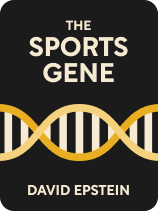

This article is an excerpt from the Shortform book guide to "The Sports Gene" by David Epstein. Shortform has the world's best summaries and analyses of books you should be reading.
Like this article? Sign up for a free trial here .
Is there such a thing as natural athleticism? What is more important when it comes to sports performance—practice or innate ability?
Different sports place different demands on the human body. Sprinters need to be fast. Soccer players need to be coordinated. Most people’s mental model of a female gymnast would be of someone small in stature, while our mental model of a basketball player is likely tall. We can train our bodies to be the best they can be at a sport, but no amount of training can override natural athleticism.
Keep reading to learn about natural athleticism and where it comes from.
Natural Athleticism
As sports become more competitive, athletes often start to look more and more similar to each other in regard to certain traits. At the most elite level, athletes competing in the same event often share remarkably similar body types. This is no coincidence.
| We All Have the Same Genes There is a common misconception that people are different from each other because we all have different genes. If this were true, there could indeed be a “sports gene” that people simply would or would not have. The reality is that all people on Earth are over 99% genetically identical to one another. This may come as a surprise, as we look, sound, and act so differently from each other. It also runs counter to the way that many people speak about genetics. People will often use phrases like “she has the gene for freckles” or, sadly, “she has the cancer gene.” When we say we have the “gene” for something, we are really referring to alleles. Alleles are different versions of a gene that lead to differences in the way that gene is expressed. Even though they account for well under one percent of our DNA, different alleles account for the huge diversity we see in the human race. For example, we all have the ABO gene, which determines our blood type, but different versions of the gene (alleles) result in different blood types between people. What we can see and observe about each other; our physical traits, our behavior, and our development is called our phenotype (this includes things like blood type, hormone levels, etc). Our phenotype is produced by the combination of our genes and our environment. When we discuss the huge diversity among athletes, we are talking about different phenotypes. (Check out Shortform’s summary of The Selfish Gene for a more in-depth discussion about how our genes influence everything about us, from our hair color to our aggressive or altruistic behaviors.) |
The Most Useful Physical Traits by Sport
Epstein notes that athletes competing in the same event at the elite level often look strikingly similar to each other. Though they may come from different corners of the globe, they often look more like each other than many siblings do in terms of body type and proportions. This is because physical features provide sport-specific advantages. The more competitive sports become, the more difficult it becomes to excel without natural athleticism.
(Shortform note: This is not to say that anything is impossible. Muggsy Bogues is famous for playing 14 seasons in the NBA at only 5 feet 3 inches.)
Next, we will explore some of the traits that Epstein highlights as being shared by athletes in the same sport and discuss how these traits provide a sport-specific advantage.
Basketball
Basketball players in the NBA are generally much taller than the average man. Only 5% of men in the US are taller than 6 feet 3 inches. The average height of an NBA player is 6 feet 7 inches. Height is a clear advantage in basketball. It puts you nearer the hoop for both shooting and rebounding and allows you to block shots more effectively while being harder to block.
A man’s chances of playing professional basketball correlate strongly with his height.
- If a man is between 6 feet and 6 feet 2 inches, he has a five in one million chance of being in the NBA.
- Men in the height range of 6 feet 10 inches to 7 feet have a 3.2% chance of being in the NBA.
- At seven feet tall, the chance of being in the NBA is 17%.
- 11% of players in the NBA are seven feet tall, a staggeringly large percent given how rare that height is in the general population.
In addition to height, having long arms is an advantage in basketball. Basketball players generally have a very large wingspan, far outside the norm for the general population. Epstein explains that arm span is a pretty good approximation of height for most of us. (For context, an arm span to height ratio greater than 1.05 is abnormal and can be a sign of a disorder called Marfan syndrome, characterized by elongated arms and legs). The average ratio for NBA players is 1.063. This means that a 6 feet 7 inches tall player can have arms that would fit a seven-foot frame.
Epstein notes that a large wingspan is an advantage in basketball, especially when blocking shots. “Shorter” players usually have an even greater wingspan to height ratio than their taller teammates, which balances out their lack of height.
- Water polo players also have large wingspans, with an additional feature. Elite water polo players have relatively longer forearms. Epstein notes that this allows them to whip the ball more effectively.
Track and Field
One size does not fit all for runners. Epstein explains that different leg lengths, leg proportions, and height have such an impact on performance that runners’ measurements often differ by event. We will look at a few examples.
Leg Length
- Hurdlers and high jumpers with long legs have a high center of gravity. For hurdlers, this means that they are able to stretch their legs out while they run to clear the hurdle, as opposed to having to make an energy-zapping vertical leap. For high jumpers, starting with a high center of gravity means that they do not have to raise their center of mass as high in order to clear the bar.
- Sprinters have proportionally longer legs than the general population. A study found that male sprinters were on average two inches taller than the average man. But all of the height difference came from having longer legs.
- Runners in the shortest sprint events tend to have shorter legs than those in longer sprints. Shorter legs allow the runner to accelerate faster. In the shortest events, much of the race is already over by the time runners reach top speed. (This is likely the reason why NFL running backs are often shorter than other players. They spend much of their time accelerating and decelerating.)
Height
- Marathon runners tend to be shorter than other runners. Provided they have similar body types, shorter athletes have a greater surface area to volume ratio than larger ones. This allows their bodies to more effectively cool themselves during long events, and can prevent heat exhaustion. Results from marathon races add anecdotal evidence to this scientific principle. For example, Epstein notes that Paula Radcliffe, the world record holder in the women’s marathon, either did not place or could not finish the race when the temperature was above 80 degrees.
Leg Proportions
- Having narrow calves is an advantage in distance running. While running, legs are like a pendulum that swings from the hips. Weight at the end of a pendulum takes more energy to swing than weight near the fulcrum. Epstein cites one study showing that running with eight additional pounds on the hips required 4% more energy. But wearing four pounds on each ankle took 24% more energy. Adding just a tenth of a pound to each ankle increases a runner’s oxygen usage (a proxy for work) by 1%.
- This may help explain Kenyan dominance in long-distance running events. Measurements from Kenyan runners showed that their calves were on average 15-17% less thick than those of a control population. This translates to nearly a whole pound of mass per calf and saves 8% of runners’ energy each kilometer compared to their peers.
Hip Width
Female sprinters generally have very narrow hips. While the average woman has wider hips than most men, Epstein explains that female sprinters’ hips tend to be more narrow than the average mans’.
Epstein cites wide hips as a biomechanical disadvantage because it creates a greater angle from the hip to the knee. Energy that could be used for forward motion is lost to compression in the hips.
Gymnastics
In a sport where athletes are often airborne and rotating, Epstein explains that the laws of physics make being small in stature an advantage. Watching the opening ceremony of the Olympic games, it is clear how small female gymnasts are compared to other athletes. The average height of a female gymnast is about 4 feet 9 inches, much shorter than the average American woman at 5 feet 4 inches, and certainly much shorter than athletes from other sports.
(Shortform note: Smaller athletes have smaller moments of inertia than larger athletes. This means that it takes less force for them to get their bodies moving into a flip, rotation, or spin than it would take a larger athlete. Larger gymnasts have to generate more force to complete the same movements. Larger athletes also have more mass farther away from their axis of rotation, which means that any rotation will require more force to initiate and will slow down faster (This is why figure skaters spin faster when they pull their arms into their bodies.))
Female gymnasts also have very narrow hips. Epstein cites the benefits of having a small, linear build as a primary reason female gymnasts are generally much younger than other Olympic athletes. Many elite female gymnasts peak in their teens and are considered “old” by the time they reach their twenties. Epstein notes that growth spurts and changes to a young athlete’s figure during puberty can be detrimental to a gymnast’s career.
(Shortform note: A study found that smaller gymnasts who had larger strength to weight ratios were better able to perform whole-body rotation skills than larger athletes. The study also found that as an athlete grew, her ability to perform specific skills (particularly back rotations) was negatively affected, while her ability to perform others was unchanged. (This may be because as athletes grow, they become more powerful, which can be an advantage for specific skills).
Epstein notes that female divers also have narrow hips, presumably for the same reason as gymnasts (their dives are entirely airborne and often include multiple rotations and flips).
Swimming
In contrast to long legs in running, longer torsos relative to height are an advantage in swimming. Epstein cites a study of Olympic athletes that found that male swimmers were 1.5 inches taller on average than Olympic sprinters, but the swimmers’ legs were half an inch shorter. All of the extra height was in their torso. Long torsos mean more surface area gliding through the water, which helps swimmers move at high speeds. Epstein highlights Michael Phelps, who is 6 feet 4 inches tall but only has a 32-inch inseam, as an example.
(Shortform note: In contrast to running events, one study of Olympic athletes found that the same body type was beneficial across all swimming events. Swimmers did not become leaner with increasing race distances as runners did.)
Weight Lifting and Water Polo
Weight lifters and water polo players share the trait of having disproportionate forearms compared to the general population. Water polo players tend to have long forearms relative to their total arm length. Epstein notes that this allows them to better “whip” the ball during play.
(Shortform note: The length of forearms in ball sports is an example of just how specific different advantageous traits can be in different sports. While a longer forearm may be useful in water polo, the opposite may be true for baseball pitchers. A pitcher’s arm forms a lever that applies force to the ball. Having a shorter forearm means less inertia at the end of the lever and allows the pitcher to release the ball at a higher speed.)
In contrast to water polo players, weight lifters often have relatively short forearms. Just as in throwing a baseball, weightlifters’ arms act as a lever to apply force to the bar. Having a shorter forearm means that the weight does not have to travel as far during lifts. Because of this, Epstein notes that the bench press may be a misleading test when it comes to selecting the most promising football players. A heavy bench press could be aided by short arms, which is not necessarily a desirable trait on the field.
(Shortform note: Short limbs provide a mechanical advantage to lifters by reducing torque as well as the total distance that the weight must be moved. (Torque can be thought of as force around an axis of rotation. The farther away the force is from the axis of rotation, the greater the torque.))

———End of Preview———
Like what you just read? Read the rest of the world's best book summary and analysis of David Epstein's "The Sports Gene" at Shortform .
Here's what you'll find in our full The Sports Gene summary :
- A look at how our genes play a determining role in our success in sports
- Why practice doesn't always guarantee success
- The fortuitous gene pairings that can lead to elite athleticism






